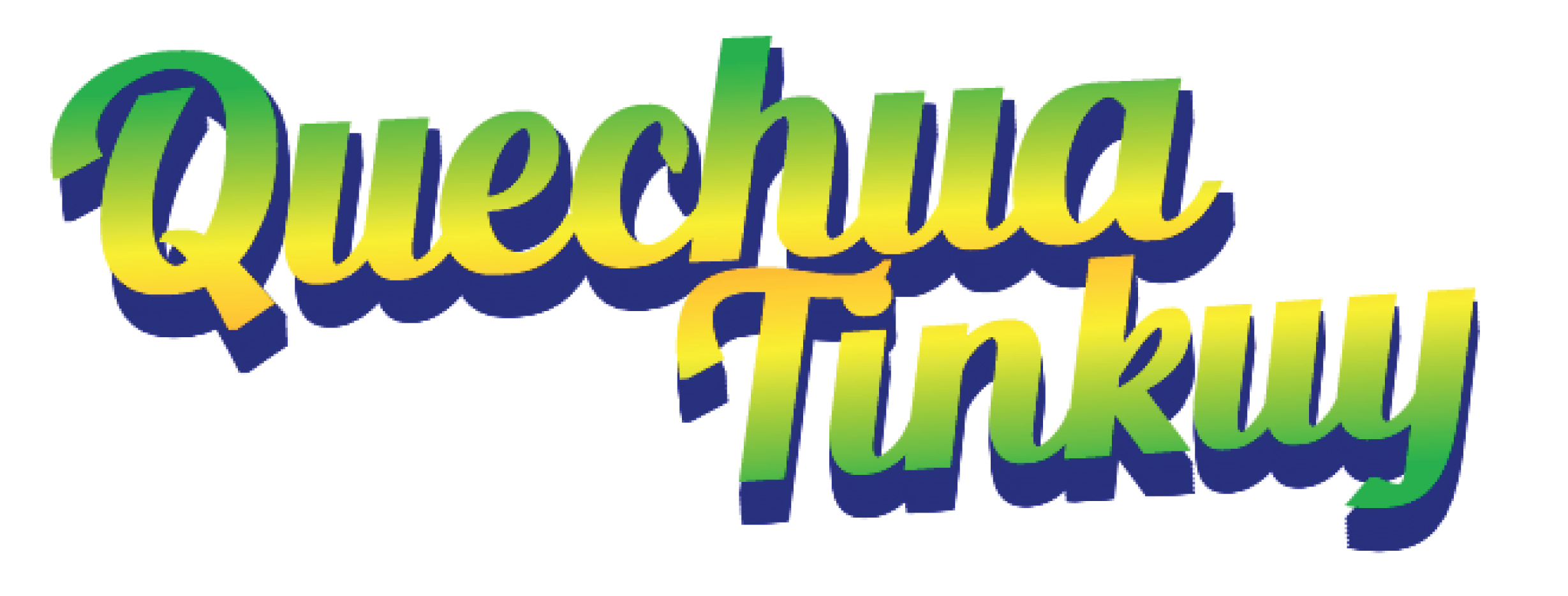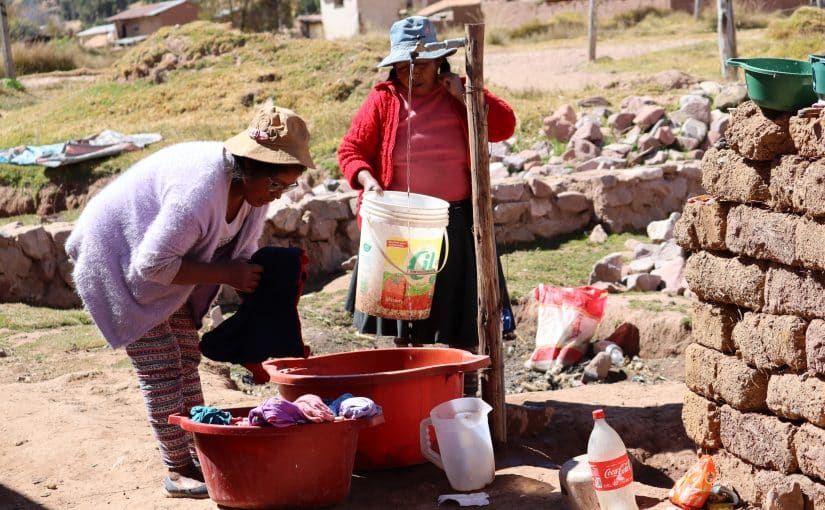
Qallarinapaq | Introduction
In this unit you will learn to conjugate the verb kani (to be) in the singular and plural forms, and in the present, past, and future. For this, we will keep in mind the personal pronouns that we learned in the previous unit and the following grammatical structure:
I am Carmen
Ñuqa Carmen kani
(I) (Carmen) (am) (literally)
She is a professor
Pay yachachiq kan
(She) (professor) (is) (literally)
They are students
Paykuna yachaqkuna kanku
(They) (students) (are) (literally)
¡Qallarisun! / Let's get started!

Qillqa | Grammar
Next, we will look at the following graph with verb conjugations with the personal pronouns:
| I am | Ñuqa kani |
| You are (singular) | Qan kanki |
| She/He/It | Pay kan |
| We (inclusive) | Ñuqanchis kanchis |
| We (exclusive) | Ñuqayku kayku |
| You (plural) | Qankuna kankichis |
| They | Paykuna kanku |
As you noted, each personal pronoun and its verb conjugation has a different ending, we will see what they are:
| I | Ñuqa verb+ni |
| You (singular) | Qan verb+nki |
| She/He/It | Pay verb+n |
| We (inclusive) | Ñuqanchis verb+nchis |
| We (exclusive) | Ñuqayku verb+yku |
| You (plural) | Qankuna verb+nkichis |
| They | Paykuna verb+nku |
Now we will conjugate the verb yachachiy to teach:
| Ñuqa yachachi-ni | I teach |
| Qan yachachi-nki | You teach |
| Pay yachachi-n | She, he teaches |
| Ñuqanchis yachachi-nchis | We taught (inclusive) |
| Ñuqayku yachachi-yku | We taught (exclusive) |
| Qankuna yachachi-nkichis | You (plural) teach |
| Paykuna yachachi-nku | They teach |
Note: For a better understanding we will use the dashes (-) as separators of a word and its suffixes, for example:
| I | I teach |
| I | yachachini |
| I | yachachi-ni |
| (subject) | (verb) (ni is the 1st person marker who does the action). |
Keep in mind the explanation of inclusive and exclusive when conjugating the pronoun we in the two forms Ñuqanchis (I) y Ñuqayku (E).
Inclusive (I): You are including yourself in the group, and also including the group that you are addressing.
Exclusive (E): You are including yourself in the group, but you are not including the group you are addressing.
Let's look at more examples: now let's try with the verb llanka’y – to work.
| Ñuqa llank’a-ni | I work |
| Qan llank’a-nki | You work |
| Pay llank’a-n | She, he works |
| Ñuqanchis llank’a-nchis | We worked (Inclusive) |
| Ñuqayku llank’a-yku | We worked (exclusive) |
| Qankuna llank’a-nkichis | You (plural) worked |
| Paykuna llank’a-nku | They worked |

Rimanakuna | Vocabulary
| Yachachiq | instructor |
| Yachaqkuna o yachakuqkuna | students |
| Wasi | house |
| Wayrawasi | radio station |
| Pampa | flat surface |
| Puriy | to walk |

Ruwapakuy | Exercises
Now we will put what we have learned in this unit into practice. Remember the verbal markers (ni, nki, n, nchis, yku, nkichis, nku), keep in mind the following structure that we have learned.
Ñuqa yachachini / I teach
Ñuqa yachachi-ni
(subject) (verb) (ni is the 1st person marker who does the action).
Qan yachachi-nki / you teach
(subject) (verb) (nki is the marker of the second person that does the action).
Now you try. Write 4 sentences using the verbal markers of your choosing with the following verbs.
Puriy = to walk, tusuy = to dance, takiy = to sing, wayk’uy = to cook
- _________________ __________________
- _________________ __________________
- _________________ __________________
- _________________ __________________
ÑUQA KA-NI / I AM
Ñuqa Qosqopi yachachini / Qosqopi Yachachini
I teach in Cusco / (I) teach in Cusco
(both sentences are correct and mean the same thing).
Let's look at more examples and in your notebook write what they mean.
Ñuqa Limapi llank’ani / Limapi llank’ani
Ñuqa Andahuaylaspi tiyani / Andahuaylaspi tiyani
Ñuqa Arequipapi yachani / Arequipapi yachani
QAN KA-NKI / YOU ARE
Qan Qosqopi yachanki / Qosqopi yachanki
You teach in Cusco / (You) teach in Cusco
Fill in the blanks. First choose a place and remember to add the locative marker «pi». Second, use the following verbs: Puriy = to walk, tusuy = to dance, takiy = to sing wayk’uy = to cook.
Qan ______ ______ / ________ ________ Qan ______ ______ / ________ ________ Qan ______ ______ / ________ ________ Qan ______ ______ / ________ ________
PAY (KA-N) / HE, SHE OR IT IS
In your notebook write what the following sentences mean:
Pay wasipi wayk’un / Wasipi wayk’un
Pay pampapi puqllan / Pampapi Puqllan
Pay chakrapi tarpun / Chakrapi tarpun
Write 2 sentences with the following verbs: qelqay = to write, t’aqwiy/k’uskiy=to research.
Pay ______ ______ / ________ ________ Pay ______ ______ / ________ ________
PAYKUNA KA-NKU / THEY ARE
In your notebook write what the following sentences mean:
Paykuna wasipi wayk’unku / Wasipi wayk’unku
Paykuna pampapi puqllanku / Pampapi Puqllanku
Paykuna chakrapi tarpunku / Chakrapi tarpunku
ÑUQANCHIS KA-NCHIS/WE ARE (INCLUSIVE)
In your notebook write what the following sentences mean:
Ñuqanchis Qosqopi tusunchis / Qosqopi tusunchis
Ñuqanchis pampapi tinkunchis / Pampapi Tinkunchis
Ñuqanchis mercadupi mikhunchis / Mercadupi mikhunchis
Write 2 sentences with the following verbs: tarpuy = to sow, yapuy = to plow.
- Ñuqanchis ______ ______ / ________ ________
- Ñuqanchis ______ ______ / ________ ________
ÑUQAYKU KA-YKU / WE ARE (EXCLUSIVE)
In your notebook write what the following sentences mean:
Ñuqayku Qosqopi tusuyku / Qosqopi tusuyku
Ñuqayku pampapi tinkuyku / Pampapi Tinkuyku
Ñuqayku mercadupi mikhuyku /Mercadupi mikhuyku
Write two sentences with the following verbs: rantiy = to buy, qhatuy = to sell.
- Ñuqayku ______ ______ / ________ ________
- Ñuqayku ______ ______ / ________ _____________
QANKUNA KA-NKICHIS / YOU ARE (PLURAL)
In your notebook write what the following sentences mean:
Qankuna Abancaypi aqhankichis / Abancaypi aqhankichis
Qankuna wayrawasipi rimankichis / Wayrawasipi rimankichis
Qankuna Carnavalpi takinkichis / Carnavalpi takinkichis
Write two sentences about your daily activities:
- Qankuna ______ ______ / ________ ________
- Qankuna ______ ______ / ________ ________

